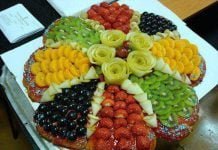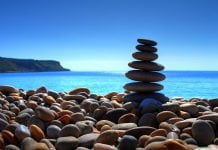The following is a “healthy food hot list” consisting of the 29 food that will give you the biggest nutritional bang for you caloric buck, as well as decrease your risk for deadly illnesses like cancer, diabetes and heart disease. Along with each description is a suggestion as to how to incorporate these power-foods into your diet.
The 29 Healthiest Foods on the Planet
01. Apricots: Beta-carotene, which helps prevent free-radical damage and protect the eyes. The body also turns beta-carotene into vitamin A, which may help ward off some cancers, especially of the skin. One apricot has 17 calories, 0 fat, 1 gram of fiber. Snacks on them dried, or if you prefer fresh, buy when still firm; once they soften, they lose nutrients.
02. Avocados: Oleic acid, an unsaturated fat that helps lower overall cholesterol and raise levels of HDL, plus a good dose of fiber. One slice has 81 calories, 8 grams of fat and 3 grams of fiber. Try a few slices instead of mayonnaise to dress up your next burger.
03. Raspberries: Ellagic acid, which helps stall cancer-cell growth. These berries are also packed with vitamin C and are high in fiber, which helps prevent high cholesterol and heart disease. A cup has only 60 calories, 1 gram of fat and 8 grams of fiber. Top plain low-fat yogurt or oatmeal (another high fiber food) with fresh berries.
04. Mango: A medium mango packs 57mg of vitamin C, almost your whole-recommended daily dose. This antioxidant helps prevent arthritis and boosts wound healing and your immune system. Mangoes also boast more than 8,000 IU of vitamin A (as beta-carotene). One mango has 135 calories, 1 gram of fat and 4 grams of fiber. Cut on up and serve it over leafy greens. Bonus: Your salad will taste like dessert!
05. Cantaloupe: Vitamin C (117mg in half a melon, almost twice the recommended daily dose) and beta-carotene – both powerful antioxidants that help protect cells from free-radical damage. Plus, half a melon has 853mg of potassium almost twice as much as a banana, which helps lower blood pressure. Half a melon has 97 calories, 1 gram of fat and 2 grams of fiber. Cut into cubes and freeze, then blend into an icy smoothie.
06. Cranberry Juice: Helps fight bladder infections by preventing harmful bacteria from growing. A cup has 144 calories, 0 grams of fat and 0 fiber. Buy 100 percent juice concentrate and use it to spice up your daily H20 without adding sugar.
07. Tomato: Lycopene, one of the strongest carotenoids, acts as an antioxidant. Research shows that tomatoes may cut the risk of bladder, stomach and colon cancers in half if eaten daily. A tomato has 26 calories, 0 fat and 1 gram of fiber. Drizzle fresh slices with olive oil, because lycopene is best absorbed when eaten with a little fat.
08. Raisins: These little gems are a great source of iron, which helps the blood transport oxygen and which many women are short on. A half-cup has 218 calories, 0 fat and 3 grams of fiber. Sprinkle raisins on your morning oatmeal or bran cereal -women, consider this especially during your period.
09. Figs: A good source of potassium and fiber, figs also contain vitamin B6, which is responsible for producing mood-boosting serotonin, lowering cholesterol and preventing water retention. The Pill depletes B6, so if you use this method of birth control, make sure to get extra B6 in your diet. One fig has 37 to 48 calories, 0 fat and 2 grams of fiber. (Cookie lovers – fig bars have around 56 calories, 1 gram of fat and 1 gram of fiber per cookie). Fresh figs are delicious simmered alongside a pork tenderloin and the dried variety make a great portable gym snack.
10. Lemons/Limes: Limonene, furocoumarins and vitamin C, all of which help prevent cancer. A wedge has 2 calories, 0 fat and 0 fiber. Buy a few of each and squeeze over salads, fish, beans and vegetables for fat free flavor.
VEGETABLES
11. Onions: Quercetin is one of the most powerful flavonoids (natural plant antioxidants). Studies show it helps protect against cancer. A cup (chopped) has 61 calories, 0 fat and 3 grams of fiber. Chop onions for the maximum phytonutrient boost, or if you hate to cry, roast them with a little olive oil and serve with rice or other vegetables.
12. Artichokes: These odd-looking vegetables contain silymarin, an antioxidant that helps prevent skin cancer, plus fiber to help control cholesterol. One medium artichoke has 60 calories, 0 fat and 7 grams of fiber. Steam over boiling water for 30 to 40 minutes. Squeeze lemon juice on top, then pluck the leaves off with your fingers and use your teeth to scrape off the rich-tasting skin. When you get to the heart, you have found the best part!
13. Ginger: Gingerols may help reduce queasiness; other compounds may help ward off migraines and arthritis pain by blocking inflammation-causing prostaglandins. A teaspoon of fresh gingerroot has only 1 calorie, 0 fat and 0 fiber. Peel the tough brown skin and slice or grate into a stir-fry.
14. Broccoli Indole-3-carbinol and sulforaphane, which help protect against breast cancer. Broccoli also has lots of vitamin C and beta-carotene. One cup (chopped) has 25 calories, 0 fat and 3 grams of fiber. Don’t overcook broccoli – instead, microwave or steam lightly to preserve phytonutrients. Squeeze fresh lemon on top for a zesty and taste, added nutrients and some vitamin C.
15. Spinach: Lutein and zeaxanthin, carotenoids that help fend off macular degeneration, a major cause of blindness in older people. Plus, studies show this green fountain of youth may help reverse some signs of aging. One cup has 7 calories, 0 fat and 1 gram of fiber. Add raw leaves to a salad or sauté with a little olive oil and garlic.
16. Bok Choy (Chinese cabbage): Brassinin, which some research suggests may help prevent breast tumors, plus indoles and isothiocyanates, which lower levels of estrogen, make this vegetable a double-barreled weapon against breast cancer. A cup will also give you 158mg of calcium (16 percent of your daily recommended requirement) to help beat osteoporosis. A cup (cooked) has 20 calories, 0 fat and 3 grams of fiber. Find it in your grocer’s produce section or an Asian market. Slice the greens and juicy white stalks, then sauté like spinach or toss into a stir-fry just before serving.
17. Squash (Butternut, Pumpkin, Acorn): Winter squash has huge amounts of vitamin C and beta-carotene, which may help protect against endometrial cancer. One cup (cooked) has 80 calories, 1 gram of fat and 6 grams of fiber. Cut on in half, scoop out the seeds and bake or microwave until soft, then dust with cinnamon.
18. Watercress and Arugula: Phenethyl isothiocyanate, which, along with beta-carotene and vitamins C and E, may help keep cancer cells at bay. One cup has around 4 calories, 0 fat and 1 gram of fiber. Do not cook these leafy greens; instead, use them to garnish asandwich or add a pungent, peppery taste to salad.
19. Garlic: The sulfur compounds that give garlic its pungent flavor can also lower LDL (“bad”) cholesterol, lower blood pressure and even reduce your risk of stomach and colon cancer. A clove has 4 calories, 0 fat and 0 fiber. Bake a whole head for 15 to 20 minutes, until soft and sweet and spread on bread instead of butter.
GRAINS/BEANS/NUTS
20. Quinoa: A half cup of cooked quinoa has 5 grams of protein, more than any other grain, plus iron, riboflavin and magnesium. A half-cup has 318 calories, 5 grams of fat and 5 grams of fiber. Add to soup for a protein boost. Rinse first, or it will taste bitter.
21. Wheat Germ: A tablespoon gives you about 7 percent of your daily magnesium, which helps prevent muscle cramps; it is also a good source of vitamin E. One tablespoon has 27 calories, 1 gram of fat and 1 gram of fiber. Sprinkle some over yogurt, fruit or cereal.
22. Lentils: Isoflavones, which may inhibit estrogen-promoted breast cancers, plus fiber for heart health and an impressive 9 grams of protein per half cup. A half-cup (cooked) has 115 calories, 0 fat and 8 grams of fiber. Isoflavones hold up through processing, so buy lentils canned, dried or already in soup. Take them to work, and you will have a protein packed lunch.
23. Peanuts: Studies show that peanuts or other nuts (which contain mostly unsaturated “good” fat) can lower your heart-disease risk by over 20 percent. One ounce has 166 calories, 14 grams of fat and 2 grams of fiber. Keep a packet in your briefcase, gym bag or purse for a protein-packed post-workout nosh or an afternoon pick me up that will satisfy you until supper, or chop a few into a stir-fry for a Thai accent.
24. Pinto Beans: A half cup has more than 25 percent of your daily requirement of folate, which helps protect against heart disease and reduces the risk of birth defects. A half-cup (canned) has 103 calories, 1 gram of fat and 6 grams of fiber. Drain a can, rinse and toss into a pot of vegetarian chill.
25. Low fat Yogurt: Bacteria in active-culture yogurt helps prevent yeast infections; calcium strengthens bones. A cup has 155 calories, 4 grams of fat, 0 grams of fiber. Get the plain kind and mix in your own fruit to keep calories and sugar down. If you are lactose intolerant, never fear – yogurt should not bother your tummy.
26. Skim Milk: Riboflavin (a.k.a. vitamin B2) is important for good vision and along with vitamin A might help improve eczema and allergies. Plus, you get calcium and vitamin D, too. One cup has 86 calories, 0 fat and 0 fiber. If you are used to high fat milk, don’t go cold turkey; instead, mix the two together at first. Trust this fact: In a week or two you won’t miss it!
SEAFOOD
27. Shellfish (Clams, Mussels): Vitamin B12 to support nerve and brain function, plus iron and hardto-get minerals like magnesium and potassium. Three ounces has 126 to 146 calories, 2 to 4 grams of fat and 0 fiber. Try a bowl of tomato-based (and low fat) Manhattan clam chowder.
28. Salmon: Cold-water fish like salmon, mackerel and tuna are the best sources of omega-3 fatty acids, which help reduce the risk of cardiac disease. A 3ounce portion (cooked) has 127 calories, 4 grams of fat, 0 fiber. Brush fillets with ginger-soy marinade and grill or broil until fish flakes easily with a fork.
29. Crab: A great source of vitamin B12 and immunity-boosting zinc. A 3ounce portion has 84 calories,
1 gram of fat, 0 fiber. The “crab” in sushi is usually made from fish; buy it canned instead and make your own crab cakes.
EATING FRUIT
This is informative!
We all think eating fruit means just buying fruit, cutting it up and popping it into our mouths. It’s not that easy. It’s important to know how and when to eat fruit.
What’s the correct way to eat fruit?
IT MEANS NOT EATING FRUIT AFTER A MEAL! FRUIT SHOULD BE EATEN ON ANEMPTY STOMACH.
Eating fruit like that plays a major role in detoxifying your system, supplying you with a great deal of energy for weight loss and other life activities.
FRUIT IS THE MOST IMPORTANT FOOD.
Let’s say you eat two slices of bread, then a slice of fruit. The slice of fruit is ready to go straight through the stomach into the intestines, but it’s prevented from doing so.
In the meantime, the whole meal rots and ferments, and turns to acid. The minute the fruit comes into contact with the food in the stomach, and digestive juices, the entire mass of food begins to spoil.
Eat your fruit on an empty stomach, or before your meal! You’ve heard people complain: Every time I eat watermelon I burp, when I eat durian my stomach bloats, when I eat a banana I feel like running to the toilet, etc. This will not happen if you eat the fruit on an empty stomach. Fruit mixes with the putrefying other food and produces gas. Hence, you bloat!
Graying hair, balding, nervous outburst, and dark circles under the eyes – all of these will NOT happen if you eat fruit on an empty stomach.
There are no such thing as some fruits, like orange and lemon are acidic, because all fruit becomes alkaline in our body, according to Dr. Herbert Shelton who did research on this matter. If you have mastered the correct way of eating fruit, you have the Secret of Beauty, Longevity, Health, Energy, Happiness and normal weight.
When you need to drink fruit juice, drink only fresh fruit juice, NOT from the cans. Don’t drink juice that has been heated. Don’t eat cooked fruit; you don’t get the nutrients at all. You get only the taste… Cooking destroys all of the vitamins.
Eating a whole fruit is better than drinking the juice. If you should drink the juice, drink it mouthful by mouthful slowly, because you must let it mix with your saliva before swallowing it. You can go on a 3-day fruit-fast to cleanse your body. Eat fruit and drink fruit juice for just 3 days, and you will be surprised when your friends say how radiant you look!
KIWI: Tiny but mighty, and a good source of potassium, magnesium, vitamin E & fiber. Its vitamin C content is twice that of an orange!
AN APPLE a day keeps the doctor away? Although an apple has a low vitamin C content, it has antioxidants & falconoid which enhances the activity of vitamin C, thereby helping to lower the risk of colon cancer, heart attack & stroke.
STRAWBERRY: Protective Fruit. Strawberries have the highest total antioxidant power among major fruits & protect the body from cancer-causing, blood vessel-clogging free radicals.
EAT 2 – 4 ORANGES a day may help keep colds away, lower cholesterol, prevent & dissolve kidney stones, and reduce the risk of colon cancer.
WATERMELON: Coolest thirst quencher. Composed of 92% water, it is also packed with a giant dose of glutathione, which helps boost our immune system. Also a key source of leucopenia, the cancer-fighting oxidant. Also found in watermelon: Vitamin C & Potassium.
GUAVA & PAPAYA: Top awards for vitamin C. They are the clear winners for their high vitamin C content. Guava is also rich in fiber, which helps prevent constipation. Papaya is rich in carotene, good for your eyes.
Drinking Cold water after a meal = Cancer! Can u believe this? For those who like to drink cold water, this applies to you. It’s nice to have a cold drink after a meal, however, the cold water will solidify the oily stuff that you’ve just consumed, which slows digestion. Once this ‘sludge’ reacts with the acid, it will break down and be absorbed by the intestine faster than the solid food. It will line the intestine. Very soon, this will turn into fats and lead to cancer. It is best to drink hot soup or warm water after a meal.
Mọi bài vở cộng tác và góp ý xin gửi về [email protected]







